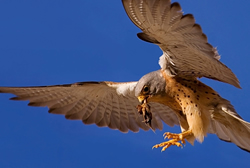|
|
Flora and Fauna
This Natural Park is the largest protected area on the Iberian Peninsula, and the second largest protected space in Europe. The spring season - between March and June - is the best time to enjoy the proliferation of flora and fauna on the estate and in the Natural Park. Local fauna includes wild boar, wild mountain goat, red and fallow deer, badgers, the lagartija de Valverde (Spanish Algyroides – a form of lizard unique to these mountains), wild cat and otters, which can be found in their natural habitats, as well as many species of fish, reptiles and insects, some of which are endangered. The Authorities have catalogued 125 different species of birds in the Natural Park, of which 26 are birds of prey. These include the Royal eagle, Bonelli’s eagle, Booted eagle, Short Toed eagle, Griffon and Common vultures, Goshawks, many types of owls, woodpeckers and peregrine falcons. Although they do not nest in the Park, Imperial eagles and Black vultures also visit the area to hunt. Bearded vultures are being re-introduced. Guided bird-watching trips can be arranged with some of the specialist adventure activity companies which supply this service. Fantastic bird sightings possible. A unique experience now is to visit and see the natural habitat of two recently released bearded vultures (Gypaetus Barbatus) which were extinct until recently in southern Spain. See Our News Page. Dawn and dusk tours of the estate can be arranged through the estate manager in order to enjoy the beauty of the landscapes and the wildlife. A unique experience is the berrea - the deer rutting season – from mid-September to beginning of October, when the mating calls of deer can be heard throughout the whole Natural Park. The flora in the Natural Park is equally interesting, from beautiful pine groves to juniper, honeysuckle, yew, strawberry trees, dragon’s teeth, holm oak, holly and many more. Over 2,000 plant species have been registered in the Natural Park with over 30 unique to this area. This makes it the second most important area for flora in Western Europe. One of the most characteristic plants is the Cazorla violet (Viola cazorlensis). |
|
Herrerías de Río Madera - Sierra de Segura - 00 34 953 496 401 / 00 34 667 588 334 - info@herreriasderiomadera.com |